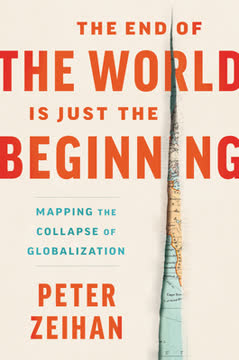Key Takeaways
1. American manufacturing's rise to global dominance (1865-1940) transformed the nation
"Between 1865 and 1900 the annual primary energy use multiplied nearly 12-fold and average per capita use nearly tripled."
Unprecedented growth. The period between the Civil War and World War II saw the United States transform from a largely agrarian economy to the world's leading industrial power. This transformation was driven by several key factors:
- Technological innovations: Steel production, electricity generation, telecommunications
- Abundant natural resources: Coal, oil, iron ore
- Large domestic market and expanding transportation networks
- Entrepreneurial spirit and business innovations
Key industries and innovations:
- Steel: Bessemer process, open-hearth furnaces
- Electricity: Edison's electric light and power systems
- Transportation: Railroads, automobiles (Ford's Model T and assembly line)
- Communications: Telephone, radio
By 1890, the US had surpassed Britain as the world's largest manufacturer, and by 1914, it produced more than a third of the world's manufactured goods.
2. World War II mobilization showcased US manufacturing prowess but masked productivity issues
"The inevitable disruptions and inefficiencies associated with a rapid mobilization for war and a similarly rapid postwar reconversion to a civilian economy meant that between 1941 and 1948, growth in manufacturing productivity was actually much lower than during the 1930s."
Wartime production surge. World War II saw an unprecedented mobilization of American industry:
- Aircraft production increased from 6,000 in 1940 to 96,000 in 1944
- Ship production rose from 23 vessels in 1941 to 1,896 in 1943
- 2.6 million trucks, 88,000 tanks, and 257,000 artillery pieces produced
This massive output was crucial to Allied victory, but it came at a cost:
- Emphasis on speed over efficiency
- Influx of inexperienced workers
- Focus on existing designs rather than innovation
Post-war challenges:
- Reconversion to civilian production
- Labor disputes and strikes
- Pent-up consumer demand vs. production bottlenecks
Despite these issues, the war left the US as the world's dominant economic and industrial power, accounting for nearly half of global manufacturing output by 1950.
3. Post-war economic expansion (1948-1973) created the first true mass consumption society
"During the quarter century of postwar economic expansion between 1948 and 1973, America's manufacturing progress made it possible to create, for better or for worse, the world's first true mass consumption society."
The American Dream realized. This period saw unprecedented growth in both production and consumption:
- GDP grew at an average annual rate of 3.8%
- Manufacturing employment peaked at 19.4 million in 1979
- Real wages doubled between 1947 and 1973
Key factors driving this boom:
- Pent-up consumer demand and high savings rates
- Technological innovations (transistors, plastics, jet engines)
- Government policies (G.I. Bill, highway construction)
- Relatively weak international competition
Consumer revolution:
- Automobile ownership: 59% of households in 1950 to 82% in 1970
- Home appliances: Washing machines, refrigerators, televisions became standard
- Suburban expansion: New housing starts averaged 1.5 million annually in the 1950s
This era of prosperity created a large middle class and set expectations for the "American way of life" that would prove difficult to maintain in later decades.
4. Oil shocks and foreign competition in the 1970s-80s signaled the beginning of manufacturing decline
"The combination of rising oil prices and declining American energy productivity made the oil shock of 1973–1974 particularly devastating for American manufacturing."
Economic headwinds. The 1970s marked a turning point for US manufacturing:
- Oil price shocks (1973 and 1979) increased energy and production costs
- Stagflation: High inflation combined with slow growth and rising unemployment
- Increased competition from rebuilt economies (Japan, Germany) and newly industrializing countries
Key industries facing challenges:
- Automotive: Japanese imports gained market share with fuel-efficient models
- Steel: Foreign producers with newer facilities outcompeted aging US plants
- Consumer electronics: Shift of production to Asia began
Policy responses:
- Voluntary export restraints (VERs) on Japanese automobiles
- Trade protections for steel industry
- Efforts to improve energy efficiency and reduce dependence on foreign oil
Despite these measures, US manufacturing's share of GDP and employment began a long-term decline. The trade deficit in manufactured goods, which first appeared in 1971, became a persistent feature of the US economy.
5. Outsourcing and offshoring accelerated the hollowing out of US manufacturing in the 1990s-2000s
"Not a single flat-screen, laptop, or tablet computer, not a single cell phone, not a single digital camera (to say nothing of TVs, DVD, and Blu-ray players, and electronic games) is now made in the United States."
Globalization's impact. The 1990s and 2000s saw an acceleration of manufacturing job losses and plant closures:
- NAFTA (1994) facilitated the movement of production to Mexico
- China's entry into the WTO (2001) opened floodgates for imports
- Advances in logistics and communication technology enabled global supply chains
Industries most affected:
- Textiles and apparel
- Furniture
- Consumer electronics
- Automotive parts
Corporate strategies:
- Outsourcing of non-core functions
- Offshoring production to low-wage countries
- Focus on design, marketing, and high-value activities
By 2010, manufacturing employment had fallen to 11.5 million, the lowest level since 1941. While overall manufacturing output continued to grow, much of this was concentrated in high-tech sectors with relatively low employment.
6. China's economic rise posed unprecedented challenges to American industrial competitiveness
"In 2010 the US trade deficit with China was more than twice as large as the combined deficit with Japan and Germany, making China the United States' most worrisome competitor and presenting the most formidable challenge because the Chinese have felt least constrained to adhere to international norms, both in domestic production and in foreign trade."
The China factor. China's rapid industrialization and export-led growth model created significant disruptions:
- Massive trade imbalance: US-China trade deficit reached $295.5 billion in 2011
- Currency manipulation accusations
- Concerns about intellectual property theft and forced technology transfers
Impact on US manufacturing:
- Job losses: Estimated 2.4 million manufacturing jobs lost to China between 2001-2008
- Downward pressure on wages
- Closure of factories and hollowing out of industrial communities
Policy challenges:
- Balancing consumer benefits of cheap imports vs. domestic job losses
- Addressing China's industrial policies and trade practices
- Maintaining competitiveness in high-tech manufacturing
The rise of China as a manufacturing powerhouse has forced a reassessment of US industrial policy and trade strategies, with ongoing debates about how to level the playing field and revitalize American manufacturing.
7. The retreat of US manufacturing has had profound economic and social consequences
"Perhaps the most disconcerting trend, income inequality resembling more the distribution of wealth in China than in Canada or France."
Economic impacts:
- Stagnant wages for middle-class workers
- Increased income inequality (Gini coefficient rose from 0.39 in 1970 to 0.48 in 2010)
- Persistent trade deficits
- Loss of innovation capacity in some sectors
Social and regional effects:
- Decline of industrial cities and regions (e.g., Detroit, Rust Belt)
- Erosion of middle-class job opportunities
- Increased economic insecurity and social dislocation
- Political polarization and populist movements
Long-term concerns:
- Loss of critical manufacturing capabilities and know-how
- Reduced capacity for innovation in some sectors
- National security implications of reliance on foreign suppliers
The decline of manufacturing has contributed to a broader trend of economic polarization, with growth concentrated in high-skill, high-wage jobs and low-skill, low-wage jobs, while middle-skill jobs have declined.
8. Calls for manufacturing revival face significant obstacles and uncertain prospects
"I see the odds of America's true manufacturing renaissance and the sector's further retreat to be no better than even."
Arguments for revival:
- National security concerns
- Need to balance trade and reduce deficits
- Potential for job creation and innovation
- Reshoring trend due to rising wages in China and automation
Challenges to revival:
- Global competition and established supply chains
- Skill gaps in the US workforce
- High corporate tax rates compared to other countries
- Regulatory burdens and infrastructure deficiencies
Potential strategies:
- Investment in education and workforce training
- Research and development support
- Tax incentives for domestic production
- Strategic industrial policy to support key sectors
While there is growing recognition of manufacturing's importance, the path to revival remains uncertain. Automation and new technologies like 3D printing may change the nature of manufacturing, potentially creating new opportunities but also limiting job growth. The future of American manufacturing will likely depend on a combination of policy choices, technological developments, and global economic trends.
Last updated:
FAQ
1. What is "Made in the USA: The Rise and Retreat of American Manufacturing" by Vaclav Smil about?
- Comprehensive historical overview: The book traces the development, achievements, and decline of American manufacturing from the post-Civil War era through the 21st century.
- Interdisciplinary analysis: Smil combines technical, economic, and social perspectives to explain how manufacturing shaped the US’s economic and strategic power.
- Focus on rise and retreat: It details the sector’s rapid growth, global dominance, and the complex factors behind its recent decline, including globalization and policy choices.
- No simple solutions: Smil avoids forecasts or prescriptions, instead offering a nuanced, evidence-based exploration of manufacturing’s past, present, and possible futures.
2. Why should I read "Made in the USA: The Rise and Retreat of American Manufacturing" by Vaclav Smil?
- In-depth, nuanced analysis: The book goes beyond surface-level explanations, exploring the technological, economic, and political forces behind American manufacturing’s evolution.
- Global perspective: Smil compares the US experience with that of Japan, Germany, and China, providing context for current trade and industrial challenges.
- Policy relevance: The book’s well-researched critiques and recommendations are valuable for policymakers, economists, and anyone interested in the future of American industry.
- Accessible and interdisciplinary: Written by a scientist, the book is approachable for general readers while offering depth for specialists.
3. What are the key takeaways from "Made in the USA" by Vaclav Smil?
- Manufacturing’s central role: Manufacturing has been the backbone of US innovation, economic growth, and national security.
- Complex causes of decline: The retreat of US manufacturing is due to a mix of globalization, policy missteps, technological change, and management failures.
- No easy renaissance: While some reshoring is happening, automation and global competition limit the potential for large-scale job recovery.
- Need for comprehensive reform: Revitalizing US manufacturing requires coordinated action in education, infrastructure, tax policy, and trade.
4. How did American manufacturing rise to global dominance according to Vaclav Smil?
- Post-Civil War transformation: The US shifted from a rural economy to the world’s leading manufacturer through mechanization and the adoption of interchangeable parts.
- Steel and infrastructure boom: Explosive growth in steel production enabled railroads, skyscrapers, and military hardware, overtaking Britain’s industrial leadership.
- Electrification and mass production: Innovations like Edison’s electric system and Ford’s assembly line revolutionized factories and made consumer goods widely accessible.
- Information age foundations: Advances in printing, telephony, and early electronics set the stage for the modern information economy.
5. What were the key achievements of American manufacturing highlighted in "Made in the USA"?
- Innovation leadership: The US pioneered electrification, mass production, and new materials, driving global productivity and economic growth.
- Wartime production: Unprecedented industrial mobilization during World War II supplied the Allies and spurred technological advances.
- Mass consumption society: Manufacturing enabled widespread prosperity, creating durable goods and supporting a broad middle class.
- Global output share: For much of the 20th century, the US accounted for about 24% of global manufacturing output.
6. Why does Vaclav Smil argue that manufacturing still matters in modern economies?
- Driver of innovation: Manufacturing remains the largest source of technical innovation, fueling growth across all sectors.
- Material foundation: Modern life depends on a vast array of manufactured goods, from infrastructure to everyday products.
- Economic multiplier: Every dollar in manufacturing generates significant additional economic activity, more than most service sectors.
- Trade and jobs impact: Manufacturing decline leads to trade deficits and job losses that services alone cannot offset.
7. What caused the decline and retreat of American manufacturing, according to Vaclav Smil?
- Global competition and offshoring: Rising competition from Japan and China led to market share losses and the relocation of production overseas.
- Policy and management failures: Short-term profit focus, underinvestment in innovation, and inadequate government support weakened competitiveness.
- Technological change: Automation and robotics reduced labor demand, while the shift to services reinforced manufacturing’s decline.
- Energy shocks and trade deficits: Oil crises and persistent trade imbalances further eroded the sector’s strength.
8. How did globalization, especially trade with China, impact US manufacturing jobs and trade deficits?
- Ballooning trade deficits: After China joined the WTO, the US trade deficit with China soared, especially in manufactured goods.
- Massive job losses: Millions of US manufacturing jobs were lost due to Chinese imports, with severe impacts in key states and regions.
- Complex interdependence: US companies benefit from low-cost Chinese manufacturing but face job losses and strategic vulnerabilities at home.
- Intellectual property and security: The shift has raised concerns about IP theft and economic security.
9. How did technological innovation in electronics, computing, and semiconductors shape US manufacturing’s evolution?
- Early US dominance: American firms invented and led in semiconductors and microprocessors, powering the computer revolution.
- Japanese competition: By the 1980s, Japan captured large shares of advanced chip markets, prompting US industry-government collaboration (SEMATECH) to regain ground.
- Software-hardware synergy: US leadership in software (Windows, Mac OS, etc.) boosted manufacturing productivity and blurred industry boundaries.
- Ongoing challenges: Despite design leadership, much chip fabrication has moved overseas, threatening future competitiveness.
10. What were the main social and economic consequences of the US manufacturing decline described by Vaclav Smil?
- Widespread job losses: Manufacturing employment dropped by millions, leading to high unemployment and underemployment in affected regions.
- Rising inequality: The loss of well-paying jobs contributed to growing income inequality and reduced social mobility.
- Urban decay: Cities like Detroit and Youngstown suffered population loss, abandoned housing, and economic distress.
- Community impacts: Deindustrialization led to social polarization and weakened the economic fabric of many communities.
11. What policy recommendations does Vaclav Smil offer for revitalizing American manufacturing?
- Tax and regulatory reform: Lowering corporate taxes and increasing R&D credits could spur investment and job creation.
- Education and workforce: Improving vocational training and STEM education is essential for supporting advanced manufacturing.
- Infrastructure and trade: Modernizing infrastructure and enforcing fair trade practices, including IP protection, are critical for competitiveness.
- Comprehensive approach needed: Success depends on coordinated reforms across multiple policy areas.
12. What are the prospects and challenges for a US manufacturing renaissance, according to "Made in the USA"?
- Limited job recovery: Automation and global supply chains mean that even with reshoring, manufacturing jobs are unlikely to return to historic levels.
- Technological transformation: Advances like 3D printing and intelligent automation will boost productivity but reduce labor demand.
- Global competition persists: Trade imbalances and foreign competition remain significant obstacles.
- Strategic commitment required: A true renaissance depends on sustained, strategic policy action and investment.
These 12 questions and answers provide a comprehensive overview of the main themes, arguments, and insights from "Made in the USA: The Rise and Retreat of American Manufacturing" by Vaclav Smil, covering the book’s historical narrative, key concepts, and policy implications.
Review Summary
Made in the USA receives mixed reviews, with an average rating of 3.75/5. Readers appreciate Smil's detailed analysis of American manufacturing's history and decline, praising his thorough research and insightful arguments. However, some find the writing style dry and difficult to follow, with an abundance of statistics. Critics note the book's pessimistic outlook but acknowledge its importance in understanding the manufacturing sector's role in the US economy. Many readers recommend it for those interested in economic history and policy, despite its challenging content.
Similar Books








Download PDF
Download EPUB
.epub digital book format is ideal for reading ebooks on phones, tablets, and e-readers.







